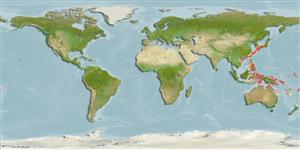Elasmobranchii (sharks and rays) >
Squaliformes (Bramble, sleeper and dogfish sharks) >
Etmopteridae (Lantern sharks)
Etymology: Etmopterus: Greek, ethmos, -ou = sieve or ethmoides bone + Greek, pteron = wing, fin (Ref. 45335).
Environment / Climate / Range
Ecology
Marine; demersal; depth range 120 - 210 m (Ref. 12704). Subtropical, preferred ?
Western Pacific: Japan, Taiwan, and Java (Indonesia).
Size / Weight / Age
Maturity: Lm ? range ? - ? cm
Max length : 30.0 cm TL male/unsexed; (Ref. 31367)
Dorsal
spines
(total): 2;
Dorsal
soft rays
(total): 0;
Anal
spines: 0;
Anal
soft rays: 0. Black flank marking on side of tail base with short truncated posterior lobe; additional oval dark marking near base of caudal fin, but no transverse marking across midlength of caudal fin (Ref. 31367).
Probably demersal on the outer continental shelves and upper slopes (Ref. 31367). Feeds on squids (Ref. 31367). Ovoviviparous (Ref. 205).
Life cycle and mating behavior
Maturity | Reproduction | Spawning | Eggs | Fecundity | Larvae
Distinct pairing with embrace (Ref. 205).
Yano, K., 1988. A new lanternshark Etmopterus splendidus from the East China Sea and Java Sea. Jap. J. Ichthyol. 34(4):421-425. (Ref. 12704)
IUCN Red List Status (Ref. 115185)
CITES (Ref. 94142)
Not Evaluated
Threat to humans
Harmless
Human uses
More information
ReferencesAquacultureAquaculture profileStrainsGeneticsAllele frequenciesHeritabilityDiseasesProcessingMass conversion
Tools
Special reports
Download XML
Internet sources
Estimates of some properties based on models
Phylogenetic diversity index (Ref.
82805): PD
50 = 0.5000 [Uniqueness, from 0.5 = low to 2.0 = high].
Trophic Level (Ref.
69278): 4.2 ±0.73 se; Based on food items.
Resilience (Ref.
69278): Low, minimum population doubling time 4.5 - 14 years (Fec assumed to be <100).
Vulnerability (Ref.
59153): Low vulnerability (16 of 100) .
